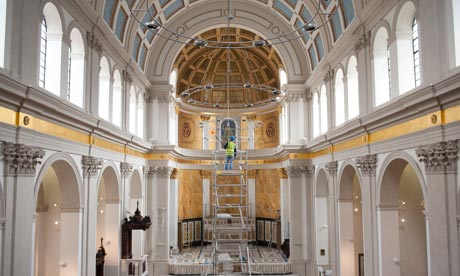A former bordello and music hall owned by one of Casanova's mistresses is perhaps an unlikely site for one of Britain's oldest Roman Catholic churches, St Patrick's, which sits amid the bright lights and fleshpots of London's Soho.
"It is not a conventional parish," observes Father Alexander Sherbrooke, who has overseen a 14-month, £3.5m project to restore the church and rid it of the damage caused by damp, dry rot, urban pollution, incense and candlelight.
It reopens this week with a specially composed Magnificat from James MacMillan and a mass from Cardinal George Pell, who is flying in from Rome for the occasion.
The traditional nature of the celebrations – vespers and canticles – highlights the contrast between the orthodoxy of St Patrick's and what lies outside it.
Sherbrooke says: "You get a knock on the door and it can be someone who is successful in business, someone who wants a sandwich or someone caught up in the sex industry. We leave our SOS prayer line calling cards in telephone boxes – where you might see other services advertised.
"One man who called said he was a pimp and wanted to break out of his occupation but that it was too lucrative for him to leave. Do we just accept the way people are? People get into ruts they find it difficult to break out of. We can say, as Christians, that God can and does intervene."
He is honest, however, about the extent to which the Catholic faith can appeal and transform.
St Patrick's is near Old Compton Street, a hub for gay men and lesbians in that part of London. When asked what kind of relationship he has with business owners he is tactful.
"The most important thing is we keep our door open. Church teaching on homosexuality is very clear. But it's a very polite relationship. As they wouldn't want to convert me, I don't go round looking to convert them. There is a respect, agreeing to disagree."
There are some gay men that attend mass, but the main constituency for St Patrick's is the capital's migrant population.
The restoration work includes the creation of a crypt, classrooms and a cafe. St Patrick's and a team of volunteers feed 80 to 90 homeless people a week with the Groucho – a private members' club – supplying the puddings.
The work to the church will allow the team to cook and serve food from one location instead of having to prepare the meals in their own kitchens and drive them into central London.
Space will also be provided for alcohol and drug counselling.
St Patrick's will be the only Roman Catholic church offering this service in London.
Inside – despite the scaffolding – the church is airy, clean and light. It is the vision of the Spanish architect Javier Castañón, who is more familiar with designing conference centres, halls of residence and high-end apartments.
St Patrick's was built on the site of Carlisle House, a mansion bought by Casanova's mistress Teresa Cornelys, who went bankrupt running a music hall and allegedly a brothel there.
It was one of the first Roman Catholic churches to be built after the Catholic Relief Acts of 1778 and 1791, which brought freedom of teaching and worship, and ministered to Irish people in the area.
The Irish have gone but migrant communities continue to be the lifeblood of the parish.
On a typical Sunday St Patrick's – or rather its temporary location at the House of St Barnabas – will attract around 700 people to five services, two in English, one in Spanish, one in Portuguese and one in Cantonese.
Alexander says: "In this part of London you don't have resident parishioners. There are tourists who know we are here and workers. It is a place where they can rest their weary feet. There is a little bit of bucking the trend going on. The loneliness of this city is more intense than you can imagine. Soho has a darkness as well as the bright lights."
Parishioners believe the church is important to Soho and to London.
Pauline Stuart, who has been part of St Patrick's for nine years, says: "We're not the establishment – we can do things that Westminster Cathedral can't. I do get comments sometimes – you know, 'what's a nice girl like you believing in all that mumbo jumbo'. But for me it's true. I don't care whether they convert or not. That's God's problem."






No comments:
Post a Comment